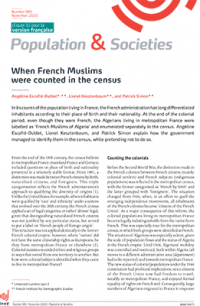When French Muslims were counted in the census
Press release Published on 02 November 2020
Population & Societies no. 583, November 2020

Authors: Angéline Escafré-Dublet, Lionel Kesztenbaum and Patrick Simon
In its counts of the population living in France, the French administration has long differentiated inhabitants according to their place of birth and their nationality. At the end of the colonial period, even though they were French, the Algerians living in metropolitan France were labelled as ‘French Muslims of Algeria’ and enumerated separately in the census. Angéline Escafré-Dublet, Lionel Kesztenbaum, and Patrick Simon explain how the government managed to identify them in the census, while pretending not to do so.
At the end of the Second World War, many Algerians came to live in France, taking advantage of strong labour market demand but also (from 1946) of their newly acquired freedom of movement as citizens of the French Union. This migration worried the French authorities who introduced a series of targeted and often discriminatory measures. One such measure was the identification of these populations in the census, the main source of statistical data on the population of France. In derogation of the law and the egalitarian principles applied in metropolitan France, INSEE applied in 1954 and 1962 a name-based method to identify Algerians present in France, who were widely categorized as ‘French Muslims of Algeria’ despite having a legal status identical to that of French natives. Statistics were thus compiled based on ethnicity and religion, unlike today’s standard census-taking practices.
Released on: 04/11/2020








